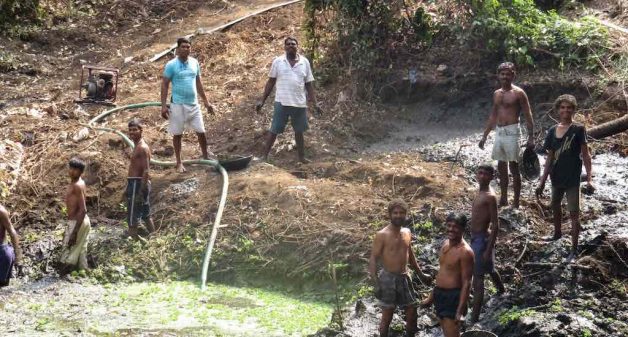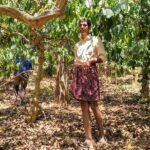Villages dotting the Vasai-Virar Sub-region (VVSR) supplied vegetables to the suburbs of Mumbai till the early 1980s. The vegetable farms were irrigated by the numerous ponds (TWPs), locally known as bavkhal.
Paddy grew in abundance in the region, betel leaf was exported to Pakistan and the finger-sized but unfailingly sweet velchi kela plantain, a favorite among the residents of Mumbai and the suburbs, were sold at a premium. Then villagers of Vasai-Virar took up jobs in the city, abandoning their farms and awaiting the opportunity to dispose them off to the highest bidder.
About 50km from the metropolis, VVSR, once considered its green lung, became the real estate destination, as housing prices in Mumbai skyrocketed in the mid-90s. As the paddy fields and the family orchards gave way to high-rise buildings, the farms and the TWPs that supported them fell into disrepair.
Given the importance of TWPs in recharging groundwater and raising the water table and their potential to serve as sources of drinking water, citizen volunteers of Vasai-Vihar are now restoring them.
Unique ecology
Located in the coastal zone north of Mumbai, demarcated by the Arabian Sea to its west and the Tungareshwar Hills to the east, Vaitarna River on its northern boundary and the Vasai creek coursing its southern arm, the twin settlement of Vasai-Virar is gifted with a unique ecological character – large tracts of wetlands, besides its proximity to the creek and the coast.
For over 205 years the Portuguese ruled Vasai or Bassein (then known as Baçaim) making it a vibrant and affluent town, building the Vasai Fort, establishing colleges, convent schools and churches – majority of them still functioning. The region has an ecology as unique as its political history.
“The 18km radius beginning from the coast of Arnala to Vasai is unique to India as it is home to lakes, ponds and TWPs,” Macanzy Dabre of Paryavaran Samvardhan Samiti, a local NGO working on ecological issues, told VillageSquare.in. “Though close to the sea, water bodies hold brackish water, linked subterraneously, each nourishing the other while the region is blessed with abundant rainfall.”

Traditional water ponds
TWP is an age-old water system existing in the wadis (orchards and vegetable farms) of coastal villages. Resembling a water hole in a forest with native trees on the periphery, a TWP is owned by families, ranging from five to 60.
TWPs served the irrigation needs of farmers. Unlike ponds, TWPs are never used for bathing or washing clothes or any of the domestic requirements. They were used only for irrigation and for recharging groundwater.
They tap the unconfined aquifer and could serve as important recharge zones to increase the groundwater table, if conserved and used properly. But that needs large-scale conservation efforts to protect the aquifer as well as preserve the only drinking water source in the region.
An exercise to this effect has been undertaken by civic-minded professionals, senior citizens and students under Yuva Vikas Sanstha (YVS), an NGO led by Sachin Marti, an alumnus of Tata Institute of Social Sciences and a Vasai resident.
Documenting TWPs
There is no record of the TWPs in terms of their numbers, physical status, usage as well as geographical density. Water bodies of Vasai-Virar including lakes were first mentioned in a book titled Samvedi Bolibhasha by Father Francis Correa, published in the early ‘80s.
Later a citizen’s initiative publication titled, Water Crisis in Vasai: A Study stated that between Arnala and Malonde and between Achole and Umelle, a 60 km radius, there were 108 lakes, of which only 28 survived. TWPs were hardly documented but for a 2007 survey conducted by the Department of Minor Irrigation that identified the existence of 479 TWPs in 27 gram panchayats.
However, the actual number of TWPs is likely to be more than that in the official records. A survey by YVS in 2013 in two villages mentioned in the records yielded more TWPs. For instance, Bhuigaon village had 39, whereas the records mention only 16, Nandakhal had 55 instead of 32, and Wagholi 54 instead of 16.
“Considering the limited freshwater reserve in the region, it may be pertinent to conduct a detailed study, so as to estimate the optimum quantum of freshwater available for withdrawal without affecting the balance of interface between the fresh and saline water,” Marti told VillageSquare.in.

Reviving TWPs
Urbanization has taken its toll and TWPs have been turned into community garbage dumping sites, lowering its potential as a water source as well as water recharge zone beside creating severe quality issues of groundwater like bacterial and chemical contamination.
YVS has been instrumental in desilting and conserving several TWPs in Sandor, Wagholi and Bhuigaon villages. The volunteers find residents of some villages lacking in support. They were unwilling to share the nominal cost of desilting, not really lacking in resources.
“It was really tough motivating people to participate in conservation efforts as they think TWPs have no role to play in their lives,” said Felix D’Souza, a teacher. “We held street plays, organized door-to-door campaigns and got the local parishes to support our efforts in order to convince people of the importance of saving them.”
Their efforts led to a TWP in Bhuigaon being repaired; it is being used by 30 families. “It was majorly funded by the civic body and was supported by the villagers,” D’Souza told VillageSquare.in.
For water sufficiency
Despite the presence of lakes, ponds and TWPs, the thirst of 13 lakh populace (as of 2012) of VVSR is quenched by tankers and bore wells. Even two neighborhood dams, namely Papalkhind and Pelhar, fail to fulfill the demand for water.
In fact, 15 million liter of water is provided by tankers from bore wells that have been drilled in plots off the Mumbai-Ahmedabad Highway. There are villagers who have become water entrepreneurs setting up reverse osmosis plants in their farms, supplying water to housing colonies and commercial establishments.
Stressing the need to save TWPs with financial support to the owners from the Panchayat Raj Institutions, Marti said, “If we can revive the TWPs, villagers who own farms can grow vegetables, take up animal husbandry and even initiate pisciculture and floriculture. They need not travel to the mainland to sell their produce for there is a big demand locally.”
Since it began work in 2011 YVS has so far desilted and helped conserve eight TWPs spread across five villages, resulting in an increase in the water table in the wells and decrease of total dissolved solids (TDS) from 750 ppm to 300 ppm. With a total number of 479 TWPs, a lot needs to be done to attain water sufficiency.
Hiren Kumar Bose is a journalist based in Thane, Maharashtra. He doubles up as a weekend farmer. Views are personal.








